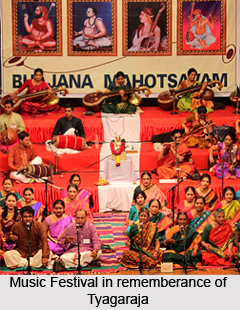 Contribution of Tyagaraja to the world of music can be better appreciated by taking stock of the raga media that he inherited. This is common to all the composers of the age. The media that Tyagaraja created was however distinct. The application of this methodology is nevertheless limited because of the fact that the raga nomenclature of the Kritis of Tyagaraja are in a state of woeful confusion.
Contribution of Tyagaraja to the world of music can be better appreciated by taking stock of the raga media that he inherited. This is common to all the composers of the age. The media that Tyagaraja created was however distinct. The application of this methodology is nevertheless limited because of the fact that the raga nomenclature of the Kritis of Tyagaraja are in a state of woeful confusion.
Tyagaraja has been unfortunate in his editors. Inspired by the Sangita Chudamani, each rare raga has been given some novel scheme by the editors. As a consequence, the existences of certain captivating melodies the contours of which have been thrown out of shape are lost, atleast temporarily. Such ignorance of the forms of rare ragas affects the attempts at estimating Thyagaraja`s musical inheritance.
Taking into account the data provided by the various editions, about 212 raga names are available. If the compositions are classified on the Melakarta ragas (Kanakangi to Rasikapriya) one will notice that the Suddha-madhyama ragas have been favoured. More than a hundred compositions are in the group of ragas under Karaharapriya, Harikamboji and Dhira Sankarabaranam. Under Pratimadhyama section there are Varali, Kalyani and Panthuvarali. Nearly half the compositions are in symmetric di tala of eight counts. There are nearly a hundred each in Chapu, Desati and Rupaka Talas. An analysis on the basis of the deities propitiated show Vaishnavite, Saivite, Utsava Sampradaya, Divyanamas in Nauka charitram and Prahlada Bhakta Vijayam put together.
Striking a balance between changing patterns and eternal values is a difficult endeavour. Theories of the system of Carnatic music have neither been dogmatic nor static. They have accommodated new conceptions in order to keep pace with the domination of an imaginative enterprise. The achievements of Thyagaraja and his contemporaries extended a call for utilization. The royal patronage from Tanjore and Madurai to music was withdrawn on account of political changes.
Gradually, the patron role passed on to zamindars and poligars. The seat of music shifted from Tanjore to Chennai. On the technical side, almost all the ragas current during the days of Sahaji are available.
This article is a stub. You can enrich by adding more information to it. Send your Write Up to content@indianetzone.com




















